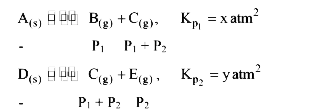Two solids dissociates as follows
 .
.
The total pressure when both the solids dissociate simultaneously is :
1. 2(√x+y) atm
2. (x+y) atm
3. √x+y atm
4. x2+y2.
2(√x+y) atm
(x+y) atm
√x+y atm
x2+y2.
The correct Answer is:A
 .
.
Kp1=P1(P1+P2)=x
Kp2=P2(P1+P2)=y
∴Kp1+Kp2=(P1+P2)2=x+y⇒P1+P2√x+y⇒2(P1+P2)=2√x+y
∴Ptotal=PB+PC+PE=2(P1+P2)=2√x+y.
Topper's Solved these Questions
- JEE MAIN REVISION TEST 8 (2020)Book:VMC MODULES ENGLISHChapter:JEE MAIN REVISION TEST 8 (2020)Exercise:CHEMISTRY (SECTION 2)
Explore 5 Videos
- JEE MAIN REVISION TEST 5 (2020)Book:VMC MODULES ENGLISHChapter:JEE MAIN REVISION TEST 5 (2020)Exercise:CHEMISTRY (SECTION 2)
Explore 5 Videos
- JEE MAIN REVISION TEST- 16Book:VMC MODULES ENGLISHChapter:JEE MAIN REVISION TEST- 16Exercise:CHEMISTRY (SECTION 2)
Explore 5 Videos
Similar Questions
Two solids dissociates as follows
A(s)→B(g)+C(g),KP1=xatm2
D(s)→C(g)+E(g),KP2=yatm2
The total pressure when both the solids dissociate simultaneously is :
View SolutionSolve the following system of equations: 2√x+3√y=2, 4√x−9√y=−1
View SolutionShow that x=2, y=1 is a solution of the system of simultaneous linear equations: 3x−2y=4; 2x+y=5 .
View SolutionThe area of the region is 1st quadrant bounded by the y-axis, y=x4,y=1+√x,andy=2√x is
View SolutionIf √a+ib=x+iy, then possible value of √a−ib is a. x2+y2 b. √x2+y2 c. x+iy d. x−iy e. √x2−y2
View SolutionIf y=√x+1√x, prove that 2xdydx+y=2√x.
View Solution(v) Solve for x and y if (√2x+√3y)=0 and (√3x−√8y)=0
View SolutionAt 600∘C,KP for the following reaction is 1 atm.
X(g)→Y(g)+Z(g)
At equilibrium, 50% of X (g) is dissociated. The total pressure of the equilibrium system is p atm. What is the partial pressure (in atm) of gases at equilibrium ?
View SolutionThe ellipse 4x2+9y2=36 and the hyperbola a2x2−y2=4 intersect at right angles. Then the equation of the circle through the points of intersection of two conics is (a) x2+y2=5 (b) √5(x2+y2)−3x−4y=0 (c) √5(x2+y2)+3x+4y=0 (d) x2+y2=25
View SolutionAn equilateral triangle whose two vertices are (−2,0)and(2,0) and which lies in the first and second quadrants only is circumscribed by a circle whose equation is :
(A) √3x2+√3y2−4x+4√3y=0(B) √3x2+√3y2−4x−4√3y=0 (C) √3x2+√3y2−4y+4√3y=0 (D) √3x2+√3y2−4y−4√3=0
View Solution

